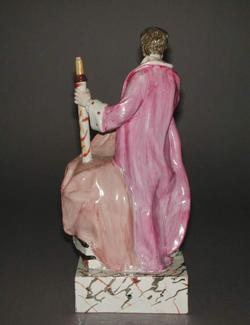Current Location: Gallery 27 (Glaisher)
Titles
Sir Isaac Newton (1642-1727)
Maker(s)
Production:
Wood, Ralph II
Production:
Wood, Ralph III
Entities
Categories
Description
Lead-glazed earthenware figure of Sir Isaac Newton standing beside a pile of books and a globe, painted in polychrome enamels
Pale cream earthenware, moulded, covered with very slightly blue tinted lead-glaze, and painted in blue, green, pale yellow, flesh pink, dull pink, purplish-puce, red, brown, and black enamels. The figure is supported on a deep-sided almost square base decorated to resemble black and grey marble. It is hollow underneath and has a ventilation hole to right of centre, and a smaller hole in the side of the back wall. Newton stands beside a pile of three books which supports a celestial globe partially covered by a cloth. His weight is on his left leg and his right knee is relaxed so that the foot is behind him. His head is turned to his right. In his left hand he supports a telescope whose lower end rests on the globe, and in his right he holds up the cloth which covers the globe. A piece of paper with a comet in relief, and the date '1680' impressed and painted in black protrudes from the uppermost book. Newton has short brown hair, rosy cheeks, and red lips. He wears a white waistcoat with purplish-puce sprigs, and blue borders, a long purplish-puce morning gown lined with white fabric with blue and red spots, pale yellow breeches, white stockings and green shoes. His telescope is marbled in yellow, and brown. The ecliptic, the other markings on the globe, and the degrees around it are in dark brown, and its stand is paler brown. The cloth over it is dull pink. One of the books has a brown cover and green text block; the next is covered in black, and the third is green with a purple text block.
Notes
History note: Sotheby’s, 9 July 1907, part of lot 47 with a figure of Chaucer; bought by Mr V.B. Button for £12 10s. on behalf of Dr J./W.L. Glaisher, FRS, Trinity College, Cambridge
Legal notes
Dr J. W. L. Glaisher Bequest
Measurements and weight
Height: 30.6 cm
Width: 14.5 cm
Acquisition and important dates
Method of acquisition: Bequeathed
(1928-12-07)
by
Glaisher, J. W. L., Dr
Dating
18th Century, Late
George III
Circa
1785
-
1800
Note
The exceptionally bright Great Comet of 1680 was discovered on 14 November by a German astronomer, Gottfried Kirch, in Coburg. It was the first comet to be identified using a telescope. Isaac Newton in 'Principia' (1687), applied his theory of gravitation to show that the 1680 comet moved in an elliptical, almost parabolic orbit round the sun. In England it became known as 'Newton's Comet', although John Flamstead's observations of the comet had played a significant part in enabling Newton to reach his conclusions.
This figure is attributed to Ralph Wood II of Burslem on the basis of examples marked 'Ra. Wood/Burslem' and the model number '137'. It was a companion to a figure of Chaucer (see C. 883-1928). It might also have been made after his death in 1795 when his son, Ralph Wood III, took over the factory in Burslem and ran it until his death in 1801.
People, subjects and objects depicted
Components of the work
Decoration
composed of
enamel
( blue, green, pale yellow, flesh pink, mauve, purplish-puce, red, brown, and black)
Surface
composed of
lead-glaze
( very slightly blue tinted)
Base
Depth 10.2 cm
Width 12.4 cm
Materials used in production
pale cream
Earthenware
Techniques used in production
Moulding
: Pale cream earthenware, moulded, covered with very slightly blue tinted lead-glaze, and painted in blue, green, pale yellow, flesh pink, mauve, purplish-puce, red, brown, and black enamels
Inscription or legends present
Inscription present: rectangular white paper stick-on label with dark blue line on three sides
- Text: illegible without microscope
- Location: On underside of base
- Method of creation: Hand-written in faded ink
- Type: Label
References and bibliographic entries
Related exhibitions
Identification numbers
Accession number: C.884-1928
Primary reference Number: 76287
Old object number: 2681
Stable URI
Audit data
Created: Saturday 6 August 2011
Updated: Monday 25 March 2024
Last processed: Tuesday 15 July 2025
Associated departments & institutions
Owner or interested party:
The Fitzwilliam Museum
Associated department:
Applied Arts





